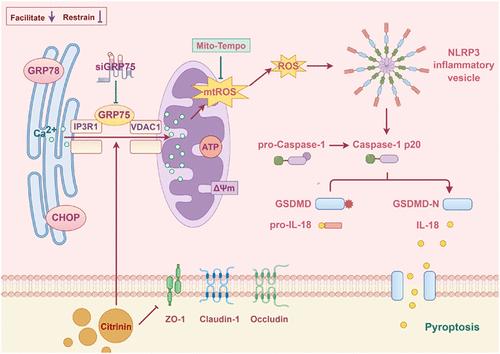Citrinin-Induced Intestinal Onset of Pyroptosis via the IP3R1–GRP75–VDAC1 Complex-Mediated Mitochondrial Oxidative Stress
IF 6.2
1区 农林科学
Q1 AGRICULTURE, MULTIDISCIPLINARY
引用次数: 0
Abstract
Citrinin (CTN) is commonly found in animal feed and stored grains and poses a serious threat to human and animal health. Formation of the IP3R1–GRP75–VDAC1 complex has been shown to play a key role in intestinal defense against harmful stimuli, but the mechanism of its action in CTN-exposure-induced enterotoxicity is not clear. Therefore, the aim of this study was to investigate the role of the IP3R1–GRP75–VDAC1 complex in CTN-exposure-induced intestinal and IPEC-J2 monolayer cell damage in mice. It was shown that CTN exposure triggered intestinal cell pyroptosis and increased IP3R1–GRP75–VDAC1 complex formation as well as mitochondrial levels of calcium ions and mitochondrial reactive oxygen species (mtROS). And mtROS is considered to be a key factor in cellular pyroptosis. Therefore, the removal of mtROS by using Mito-Tempo was found to attenuate CTN-exposure-induced cellular pyroptosis but failed to attenuate mitochondrial calcium ion overload. However, silencing of GRP75 alleviated CTN-exposure-induced increases in the level of mtROS, mitochondrial calcium ions, and subsequent cellular pyroptosis. Therefore, this study confirms that CTN exposure induces cellular juxtaposition in intestinal tissues and points out that mitochondrial oxidative stress mediated by the IP3R1–GRP75–VDAC1 complex is a key mechanism by which CTN exposure triggers intestinal cellular pyroptosis.

柑桔素通过IP3R1-GRP75-VDAC1复合物介导的线粒体氧化应激诱导肠道热亡
桔霉素(Citrinin, CTN)普遍存在于动物饲料和储粮中,对人类和动物的健康构成严重威胁。IP3R1-GRP75-VDAC1复合物的形成已被证明在肠道防御有害刺激中发挥关键作用,但其在ctn暴露诱导的肠毒性中的作用机制尚不清楚。因此,本研究的目的是探讨IP3R1-GRP75-VDAC1复合物在ctn暴露诱导的小鼠肠道和IPEC-J2单层细胞损伤中的作用。结果表明,CTN暴露引发肠细胞热亡,增加IP3R1-GRP75-VDAC1复合物的形成以及线粒体钙离子和线粒体活性氧(mtROS)水平。mtROS被认为是细胞热亡的关键因素。因此,使用Mito-Tempo去除mtROS被发现可以减轻ctn暴露诱导的细胞焦亡,但不能减轻线粒体钙离子过载。然而,GRP75的沉默减轻了ctn暴露引起的mtROS水平升高、线粒体钙离子水平升高以及随后的细胞焦亡。因此,本研究证实了CTN暴露诱导肠道组织细胞并置,并指出IP3R1-GRP75-VDAC1复合物介导的线粒体氧化应激是CTN暴露引发肠道细胞热亡的关键机制。
本文章由计算机程序翻译,如有差异,请以英文原文为准。
求助全文
约1分钟内获得全文
求助全文
来源期刊
CiteScore
9.90
自引率
8.20%
发文量
1375
审稿时长
2.3 months
期刊介绍:
The Journal of Agricultural and Food Chemistry publishes high-quality, cutting edge original research representing complete studies and research advances dealing with the chemistry and biochemistry of agriculture and food. The Journal also encourages papers with chemistry and/or biochemistry as a major component combined with biological/sensory/nutritional/toxicological evaluation related to agriculture and/or food.

 求助内容:
求助内容: 应助结果提醒方式:
应助结果提醒方式:


